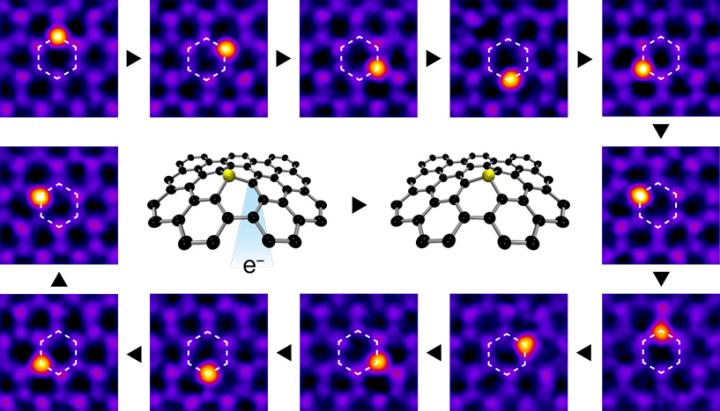Manipulating single atoms with an electron beam

An electron beam focused on a carbon atom next to a silicon impurity atom can controllably make it jump to where the beam was placed. Step by step this allows the silicon to be moved with atomic precision around a hexagonal path. Credit: © CC-BY, Toma Susi / University of Vienna
As an epoch-making achievement in nanotechnology, the scanning tunneling microscope has since the late 1980s been able to move atoms over surfaces, and has until very recently been the only technology capable of moving individual atoms in such a controlled manner.
Now, the scanning transmission electron microscope (STEM) is able to reliably focus an electron beam with sub-atomic precision, allowing scientists to directly see each atom in two-dimensional materials like graphene, and also to target single atoms with the beam. Each electron has a tiny chance of scattering back from a nucleus, giving it a kick in the opposite direction.
Building on work published over the past few years, a research team at the University of Vienna led by Toma Susi has now used the advanced electron microscope Nion UltraSTEM100 to move single silicon atoms in graphene with truly atomic precision.
Even with manual operation, the achieved movement rate is already comparable to the state-of-the-art in any atomically precise technique. “The control we are able to achieve by essentially directing the electron beam by hand is already remarkable, but we have further taken the first steps towards automation by detecting the jumps in real time”, says Susi.
The new results also improve theoretical models of the process by including simulations by collaborators in Belgium and Norway.
In total, the researchers recorded nearly 300 controlled jumps. Additional to extended paths or moving around a single hexagon made of carbon atoms in graphene, a silicon impurity could be moved back and forth between two neighboring lattice sites separated by one tenth-billionth of a meter, like flipping an atomic-sized switch.
In principle, this could be used to store one bit of information at record-high density. Dr. Susi concludes, “Your computer or cellphone will not have atomic memories anytime soon, but graphene impurity atoms do seem to have potential as bits near the limits of what is physically possible.”
###
Main funding for this work came from the European Research Council (ERC) and the Austrian Science Fund (FWF).
Publication:
Electron-Beam Manipulation of Silicon Dopants in Graphene: Mukesh Tripathi, Andreas Mittelberger, Nicholas Pike, Clemens Mangler, Jannik C. Meyer, Matthieu Verstraete, Jani Kotakoski, and Toma Susi. Nano Letters Article ASAP, DOI: 10.1021/acs.nanolett.8b02406.
Media Contact
All latest news from the category: Power and Electrical Engineering
This topic covers issues related to energy generation, conversion, transportation and consumption and how the industry is addressing the challenge of energy efficiency in general.
innovations-report provides in-depth and informative reports and articles on subjects ranging from wind energy, fuel cell technology, solar energy, geothermal energy, petroleum, gas, nuclear engineering, alternative energy and energy efficiency to fusion, hydrogen and superconductor technologies.
Newest articles

First-of-its-kind study uses remote sensing to monitor plastic debris in rivers and lakes
Remote sensing creates a cost-effective solution to monitoring plastic pollution. A first-of-its-kind study from researchers at the University of Minnesota Twin Cities shows how remote sensing can help monitor and…

Laser-based artificial neuron mimics nerve cell functions at lightning speed
With a processing speed a billion times faster than nature, chip-based laser neuron could help advance AI tasks such as pattern recognition and sequence prediction. Researchers have developed a laser-based…

Optimising the processing of plastic waste
Just one look in the yellow bin reveals a colourful jumble of different types of plastic. However, the purer and more uniform plastic waste is, the easier it is to…



